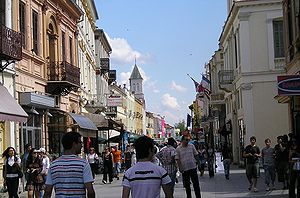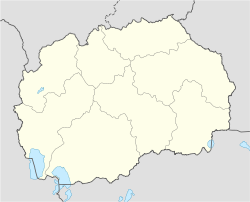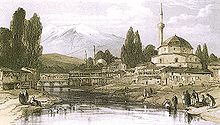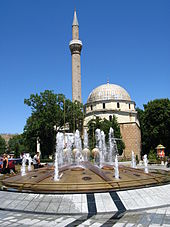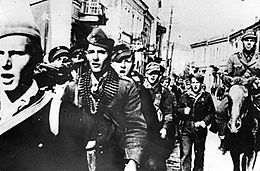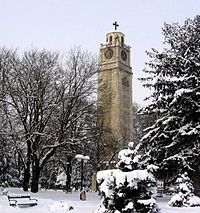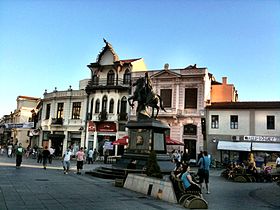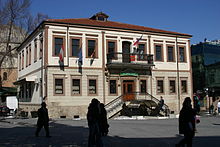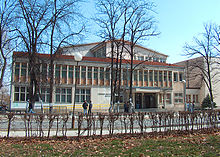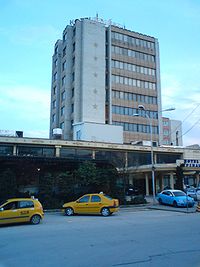- Bitola
-
"Manastir" redirects here. For other uses, see Manastir (disambiguation) and Monastir (disambiguation).
Bitola
БитолаŠirok Sokak street 
FlagNickname(s): "the city of consuls" Motto: Bitola, babam Bitola Coordinates: 41°01′55″N 21°20′05″E / 41.03194°N 21.33472°ECoordinates: 41°01′55″N 21°20′05″E / 41.03194°N 21.33472°E Country  Macedonia
MacedoniaMunicipality Bitola municipality Government – Mayor Vladimir Taleski Area – City 422.39 km2 (163.1 sq mi) Elevation +576 m (1,890 ft) Population (2002) – City 95,385 – Metro 122,173 Time zone CET (UTC+1) Postal codes 7000 Area code(s) 389 047 Patron saints Saint Nectarios of Bitola[1] Website http://www.bitola.gov.mk Bitola (Macedonian: Битола [ˈbitɔɫa] (
 listen), formerly Monastir or Manastır; known also by several alternative names) is a city in the southwestern part of the Republic of Macedonia. The city is an administrative, cultural, industrial, commercial, and educational centre. It is located in the southern part of the Pelagonia valley, surrounded by the Baba and Nidže mountains, 14 km north of the Medžitlija-Níki border crossing with Greece. It is an important junction connecting the south of the Adriatic Sea with the Aegean Sea and Central Europe. It has been known since the Ottoman period as "the city of the consuls", since many European countries have consulates in Bitola. According to some sources, Bitola is the second[2] or third[3] largest town in the country, competing with Kumanovo. Bitola is also the seat of the Bitola Municipality.
listen), formerly Monastir or Manastır; known also by several alternative names) is a city in the southwestern part of the Republic of Macedonia. The city is an administrative, cultural, industrial, commercial, and educational centre. It is located in the southern part of the Pelagonia valley, surrounded by the Baba and Nidže mountains, 14 km north of the Medžitlija-Níki border crossing with Greece. It is an important junction connecting the south of the Adriatic Sea with the Aegean Sea and Central Europe. It has been known since the Ottoman period as "the city of the consuls", since many European countries have consulates in Bitola. According to some sources, Bitola is the second[2] or third[3] largest town in the country, competing with Kumanovo. Bitola is also the seat of the Bitola Municipality.Contents
Etymology
According to Adrian Room, the name Bitola is derived from the old Slavic word Obitel (monastery or abode), since the city was formerly noted for its monastery. When the meaning of the name was no longer understood, it lost its prefix "o".[4] The name Bitola is mentioned in the Bitola inscription, related to the old city fortress built in 1015. Modern Slavic variants include the Macedonian Bitola (Битола), the Serbian Bitolj (Битољ) and Bulgarian Bitolya (Битоля). In Byzantine times, the name was hellenized to Voutélion (Βουτέλιον) or Vitólia (Βιτώλια), hence the names Butella by William of Tyre, Butili by the Arab geographer al-Idrisi. The Aromanian name Bituli is also derived from the Slavic name.
Another Greek name under which the city used to be best-known and which is still in use, is Monastíri (Μοναστήρι), also meaning "monastery". The Turkish name Manastır (Ottoman Turkish: مناستر) is derived from the Greek name, as is the Albanian Manastiri.
Geography
Bitola is located in the southwestern part of Macedonia. The Dragor River flows through the city. Bitola lies at an elevation of 615 meters above sea level, at the foot of Baba Mountain. Its magnificent Pelister mountain (2601 m) is a national park with exquisite flora and fauna, among which the rarest species of pine, known as Macedonian pine or pinus peuce, as well as a well-known ski resort.
Covering an area of 1,798 km². and with a population of 122,173 (1991), Bitola is an important industrial, agricultural, commercial, educational, and cultural center. It represents an important junction that connects the Adriatic Sea to the south with the Aegean Sea and Central Europe.
History
Prehistory
The Bitola area is very rich in monuments from the prehistoric period. Two important ones are Veluška Tumba, and Bara Tumba near the village of Porodin. From the Copper Age there are the settlements of Tumba near the village of Crnobuki, Shuplevec near the village of Suvodol, and Visok Rid near the village of Bukri. The Bronze Age is represented by the settlements of Tumba near the village of Kanino and the settlement with the same name near the village of Karamani.
Ancient and early Byzantine periods
There are important metal artifacts from the ancient period at the necropolis of Crkvishte near the village of Beranci. A golden earring dating from the 4th century BC is depicted on the obverse of the Macedonian 10 denars banknote, issued in 1996.[5]
Heraclea Lyncestis (Greek: Ηράκλεια Λυγκηστίς[6] - City of Hercules upon the Land of the Lynx) was an important settlement from the Hellenistic period till the early Middle Ages. It was founded by Philip II of Macedon by the middle of the 4th century BC, and named after the Greek demigod Heracles, whom Philip considered his ancestor. With its strategic location, it became a prosperous city. The Romans conquered this part of Macedon in 148 BC and destroyed the political power of the city. However, its prosperity continued mainly due to the Roman Via Egnatia road which passed near the city. Several monuments from the Roman times remain in Heraclea, including a portico, thermae (baths), an amphitheater and a number of basilicas. The theatre was once capable of housing an audience of around 3,000 people.
In the early Byzantine period (4th to 6th centuries AD) Heraclea was an important episcopal centre. Some of its bishops were mentioned in the acts of the Church Councils, including Bishop Evagrius of Heraclea in the Acts of the Sardica Council of 343 AD. A small and a great (Large) basilica, the bishop's residence, and a funeral basilica near the necropolis are some of the remains of this period. Three naves in the Great Basilica are covered with mosaics of very rich floral and figurative iconography; these well preserved mosaics are often regarded as fine examples of the early Christian art period. During the 4th and 6th centuries, the names of other bishops from Heraclea were recorded. The city was sacked by Ostrogothic forces, commanded by Theodoric the Great in 472 and, despite a large gift to him from the city's bishop, it was sacked again in 479.
It was restored in the late 5th and early 6th centuries. In the late 6th century the city suffered successive attacks by Slavic tribes and was gradually abandoned.
Arrival of the Slavs
In the 6th and 7th centuries, the region around Bitola experienced a demographic shift as more and more Slavic tribes settled in the area. In place of the deserted theater, several houses were built during that time. The Slavs also built a fortress around their settlement. Bitola became a part of the First Bulgarian Empire from late 8th to early 11th centuries. The spread of Christianity was assisted by St. Clement of Ohrid and Naum of Preslav in the 9th and early 10th centuries. Many monasteries and churches were built in the city.
In the 10th century, Bitola was under the rule of tsar Samuil. He built a castle in the town, later used by his successor Gavril Radomir of Bulgaria. The town is mentioned in several medieval sources. John Skylitzes's 11th century chronicle mentions that Emperor Basil II burned Gavril's castles in Bitola, when passing through and ravaging Pelagonia. The second chrysobull (1019) of Basil II mentioned that the Bishop of Bitola depended on the Archbishopric of Ohrid. During the reign of Samuil, the city was an important centre in the Bulgarian state and the seat of the Bitola Bishopric. In many medieval sources, especially Western, the name Pelagonia was synonymous with the Bitola Bishopric, and in some of them Bitola was known under the name of Heraclea due to the church tradition that turned the Heraclea Bishopric into the Pelagonian Metropolitan's Diocese. In 1015, tsar Gavril Radomir was killed by his cousin Ivan Vladislav, who declared himself tsar and rebuilt the city fortress. To celebrate the occasion, a stone inscription written in the Cyrillic alphabet was set in the fortress; in it the Slavic name of the city is mentioned: Bitol.
Following battles with tsar Ivan Vladislav, Byzantine emperor Basil II recaptured Monastiri in 1015. The town is mentioned as an episcopal centre in 1019 in a record by Basil II. Two important uprisings against Byzantine rule took place in the Bitola area in 1040 and 1072. After the Bulgarian state was restored in late 11th century, Bitola was incorporated under the rule of tsar Kaloyan of Bulgaria. It was conquered again by Byzantium at the end of the 13th century, but it became part of Serbia in the first half of the 14th century, after the conquests of Stefan Dušan.
As a military, political and cultural center, Bitola played a very important role in the life of the medieval society in the region, prior to the Ottoman conquest in the mid-14th century. On the eve of the Ottoman conquest, Bitola (Monastir in Ottoman Turkish) experienced great growth with its well-established trading links all over the Balkan Peninsula, especially with big economic centers like Constantinople, Thessalonica, Ragusa and Tarnovo. Caravans of various goods moved to and from Bitola.
Ottoman rule
From 1382 to 1912, Manastır (now Bitola) was part of the Ottoman Empire. Fierce battles took place near the city during the arrival of Turkish forces. Turkish rule was completely established after the death of Prince Marko in 1395. For several centuries, Turks were a majority in this city, while the villages were populated mostly with Slavs. Evliya Çelebi says in his Book of Travels that the city had 70 mosques, several coffee-tea rooms, a bazaar (market) with iron gates and 900 shops. Manastır became a sanjak centre in the Rumelia Eyalet (Ottoman province).
After the Austro-Ottoman wars, the trade development and the overall thriving of the city was stifled. But in late 19th century, it again it became the second-biggest city in the wider southern Balkan region after Salonica. The city is also known as "city of consuls", because 12 diplomatic consuls resided here from 1878 to 1913.
In 1864, Manastır became the center of Monastir eyalet which included the sanjaks of Debra, Serfidze, Elbasan, Manastır (Bitola), Görice and towns of Kırcaova, Pirlepe, Florina, Kesriye and Grevena.
Traditionally a strong trading center, Bitola is also known as "the city of the consuls". At one time during the Ottoman rule, Bitola had consulates from twelve countries. During the same period, there were a number of prestigious schools in the city, including a military academy that, among others, was attended by the famous Turkish reformer Kemal Atatürk. Bitola was also the headquarters of many cultural organizations that were established at that time.
There are opposing ethnographic data from that period, but it appears that no specific ethnic or religious group could claim an absolute majority of the population. According to the 1911 Ottoman census, Greeks were the largest Christian population in the vilayet, with 740,000 Greeks, 517,000 Bulgarians and 1,061,000 Muslims in the vilayets of Selanik (Thessaloniki) and Manastır. However, it should be noted that the basis of the Ottoman censuses was the millet system. People were assigned an ethnicity according to their religion. So all Sunni Muslims were categorised as Turks and all members of the Greek Orthodox church as Greeks, although their numbers included a vast majority of Aromanians and some Macedonian Slavs. The rest were divided between Bulgarian and Serb Orthodox churches.[7] (Also see "Jewish community" below.) But the Ottoman register of Bedel-I Askeriye Tax of 1873 says the Manastır vilayet had about 150,000 Bulgarian men (heads of households), 40,000 Muslim and only 700 Greek. Ottoman population data from 1901 counts 566,000 Slavs, 363,000 Turks and 260,000 Greeks in the Thessaloniki and Manastır vilayets.[1].
In 1894, Manastır was connected with Selanik by train. The first motion picture made in the Balkans was recorded by the Aromanian Manakis brothers in Manastır in 1903. In their honour, the annual Manaki Brothers International Film Camera Festival is held in modern Bitola. The Congress of Monastir of 1908 which defined the modern Albanian alphabet was held in the city.
Ilinden Uprising
The Bitola region was a stronghold of the Ilinden Uprising. The uprising was started as decided in 1903 in Thessaloniki by the Internal Macedonian Revolutionary Organization (IMRO). Gotse Delchev opposed the timing of the uprising, saying that the people were not ready. He was killed on 4 May 1903 near Banitza village (today in Greece). The uprising in the Bitola region was planned in Smilevo village in May 1903. The battles were fought in the villages of Bistrica, Rakovo, Buf, Skocivir, Paralovo, Brod, Novaci, Smilevo, Gjavato, Capari and others. Smilevo was defended by 600 rebels led by Dame Gruev and Georgi Sugarev, but when they were defeated, villages were burned.
Balkan wars
In 1912, Montenegro, Serbia, Bulgaria and Greece fought the Ottomans in the First Balkan War. According to the Treaty of Bucharest, 1913, the region of Macedonia was divided in 3 parts among Greeks, Serbs and Bulgarians. Bitola was to be in Bulgaria, according to a pre-war alliance agreement between Bulgaria and Serbia. But the Serbian army entered the city and refused to hand it to Bulgaria. From that moment, the city started to lose its importance and the population started rapidly decreasing, emigrating outside Macedonia and to the New World. A former dragoman who witnessed the Balkan Wars noted in January 1914 that "hardly a year has elapsed since Monastir fell into Servian hands, and this very short period has been enough to turn it into a desert city."[8]
World War I
During World War I Bitola was on the Thessaloniki front line. In 1915 Bulgarian forces took the city and the Serb forces were forced to either surrender or try a dangerous escape through the Albanian mountains. In 1916, Bitola was occupied by the Allied Powers which entered the city from the South fighting the Bulgarian army. Bitola was divided into French, Russian, Italian and Serbian regions, under the command of French general Maurice Sarrail. Until Bulgaria's surrender in late autumn 1918, Bitola remained a front line city and was almost every day bombarded by airplanes and battery and suffered almost total destruction.
Between the two world wars
After the end of World War I (1918) Bitola was included in the Kingdom of Serbs, Croats and Slovenes, later called the Kingdom of Yugoslavia. The city became a neglected border town, just 14 kilometres from Greece. Bitola's decline continued throughout this period, together with the general decline in Vardarska Banovina (Vardar Banovina), which remained one of the poorest regions in Yugoslavia.
World War II
During the World War II (1941–1945), the Germans and later Bulgarians took control of the city. But in September 1944, Bulgaria switched sides in the war and withdrew from Yugoslavia, and Bitola was freed by Macedonian pro-Titoist Partisans. On 4 November, the 7th Macedonian Liberation Brigade entered Bitola victoriously. After the end of the war, a Macedonian state was established for the first time in modern history, within Yugoslavia. This had cost about 25,000 human lives. In 1945, the first Gymnasium (named "Josip Broz Tito") to use the Macedonian language, was opened in Bitola.
Jewish community
After the Expulsion of 1492, Spanish-speaking Jews harassed and persecuted by the Inquisition, accepted by Sultan Bayezid II to the Ottoman territories and arrived in waves from the Iberian peninsula (Spain and Portugal). A majority settled in Salonika, but a large community grew in Monastir and made up over ten percent of the city's population in 1900. The local Jewish population referred to themselves as Monastirli, and a Monastirli synagogue exists to this day in modern Thessaloniki.[9]
There was little evidence of anti-Semitism among other local communities. The Jews and the Aromanians were the only communities who did not make a national claim on Macedonian territory and were generally seen as neutral in these disputes.
Most Jews of Monastir were murdered during the Holocaust, and at present none remain in the city.[10]
Main sights
The city has many historical building dating from many historical periods. The most notable ones are from the Ottoman age, but there are some from the more recent past.
Clock Tower
It is unknown when Bitola's clock tower was built. Written sources from the 16th century mention a clock tower, but it is not clear if it is the same one. Some believe it was built at the same time as St. Dimitrija Church, in 1830. Legend says that the Ottoman authorities collected around 60,000 eggs from nearby villages and mixed them in the mortar to make the walls stronger.
The tower has a rectangular base and is about 30 meters high. Near the top is a rectangular terrace with an iron fence. On each side of the fence is an iron console construction which holds the lamps for lighting the clock. The clock is on the highest of three levels. The original clock was replaced during World War II with a working one, given by the Nazis because the city had maintained German graves from World War I. The massive tower is composed of walls, massive spiral stairs, wooden mezzanine constructions, pendentives and the dome. During the construction of the tower, the façade was simultaneously decorated with simple stone plastic.
Church of Saint Demetrius
The Church of Saint Demetrius was built in 1830 with voluntary contributions of local merchants and craftsmen. It is plain on the outside, as all churches in the Ottoman Empire had to be, but of rare beauty inside, lavishly decorated with chandeliers, a carved bishop throne and an engraved iconostasis. According to some theories, the iconostasis is a work of the Miyak engravers. Its most impressive feature is the arc above the imperial quarters with modeled figures of Jesus and the apostles.
Other engraved wood items include the bishop's throne made in the spirit of Miyak engravers, several icon frames and five more-recent pillars shaped like thrones. The frescoes originate from two periods: the end of the 19th century, and the end of World War I to the present. The icons and frescoes were created thanks to voluntary contributions of local businessmen and citizens. The authors of many of the icons had a vast knowledge of iconography schemes of the New Testament. The icons show a great sense of color, dominated by red, green and ochra shades. The abundance of golden ornaments is noticeable and points to the presence of late-Byzantine artwork and baroque style. The icon of Saint Demetrius is signed with the initials "D. A. Z.", showing that it was made by iconographer Dimitar Andonov the zograph in 1889. There are many other items, including the chalices made by local masters, a darohranilka of Russian origin, and several paintings of scenes from the New Testament, brought from Jerusalem by pilgrims.
The opening scenes of the film The Peacemaker were shot in the "St. Dimitrija" church in Bitola, as well as some Welcome to Sarajevo scenes.
Ajdar-kadi mosque
The Ajdar-kadi (Turkish judge) Mosque is one of the most attractive monuments of Islamic architecture in Bitola. It was built in the early 1560s, as the project of the famous architect Mimar Sinan, ordered by the Bitola kadija Ajdar-kadi. Over time, it was abandoned and heavily damaged, but recent restoration and conservation has restored to some extent its original appearance.
Jeni mosque
The Jeni mosque is located in the center of the city. It has a square base, topped with a dome. Near the mosque is a minaret, 40 m high. Today, the mosque's rooms house permanent and temporary art exhibitions. Recent archaeological excavations have revealed that it has been built upon an old church.
Ishak mosque
The Ishak mosque is the inheritance of the kadi Ishak Çelebi. In its spacious yard are several tombs, attractive because of the soft, molded shapes of the sarcophagi.
The old bazaar
The old bazaar (Macedonian: Стара Чаршија) is mentioned in a description of the city from the 16th and the 17th century. The present bezisten does not differ much in appearance from the original one. The bezisten had 86 shops and 4 large iron gates. The shops used to sell textiles, and today sell food products.
Deboj Bath
The Deboj Bath is a Turkish bath (hamam). It is not known when exactly it was constructed. At one point, it was heavily damaged, but after repairs it regained its original appearance: a beautiful façade, two large domes and several minor ones.
Bitola today
Stopanska Banka headquarters
Bitola is the economic and industrial center of southwestern Macedonia. Many of the largest companies in the country are based in the city. The Pelagonia agricultural combine is the largest producer of food in the country. The Streževo water system is the largest in the Republic of Macedonia and has the best technological facilities. The three thermoelectric power stations of REK Bitola produce nearly 80% of electricity in the state. The Frinko refrigerate factory was a leading electrical and metal company. Bitola also has significant capacity in the textile and food industries.
Bitola is also home to eleven consulates, which gives the city the nickname "the city of consuls."
In November 2011, Hungary also expressed interest in opening a consulate in Bitola.[11]
Media
There are three Bitola Television Stations: TERA, Orbis and Medi, four regional radio stations: the state Radio Bitola, and the private Radio 105, Aktuel Bombarder and Radio Delfin as well as a local weekly newspaper — Bitolski Vesnik.
Demography
As of 2002, the municipality of Bitola has 95,385 inhabitants and the ethnic composition was the following:[12]
- Macedonians - 84,616 (88.7%)
- Albanians - 4,164 (4.3%)
- Roma - 2,613 (2.7%)
- Turks - 1,610 (1.7%)
- Aromanians - 1,270 (1.3%)
- Serbs - 541 (0.6%)
- Bosniaks - 21 (0.02%)
- others - 550 (0.68%)
Culture
- Heraclea Festival
The "Heraclea Festival" or also known as "Heraclea Evenings" is a summer event that takes places throughout the whole summer and its main concentration is on theater, art, and music. At the moment, the Heraclea Festival is highly appraised European Festival with a determined future for its artistic conception and tendency for a new vision for the next millennium.
- Manaki Festival of Film and Camera
In memories of the first cameramen on the Balkans, Milton Manaki, every September the Film and Photo festival "Brothers Manaki" takes place. It is a combination of documentary and full-length films that are being shown. The festival is a world class event and it is a must see.
- Ilindenski Denovi
Every year, the traditional folk festival "Ilinden Days" takes place in Bitola. It is a 4-5 day festival of music, songs, and dances that is dedicated to the Ilinden Uprising against the Turks, where the main concentration is placed on the folk culture of Macedonia. Folk dances and songs are presented with many folklore groups and organizations taking part in it.
- Small Monmartre of Bitola
In the last few years, the Art manifestation "Small Monmartre of Bitola" that is organized by the art studio "Kiril and Metodij" has turned into a successful children's art festival. Children from all over the world come to express their imagination through art, creating important and priceless art that is presented in the country and around the world. "Small Monmartre of Bitola" is a winner of numerous awards and nominations.
- Serenada on Sirok-sokak
Bitola, Sirok-sokak, love, friends, singing, drinking.... remembering the old days in cosmopolitan Bitola, the most modern city since the time of the Consuls. This is the reason the festival "Serenada on Sirok sokak" was created by artist and musicians from Bitola and since then it is organized every year. About 25-30 songs are performed in 2 days, and what is significant about the festival is that artist perform live. Awards are given according to audience decision.The general manager of festival is Mile Serdenkov.
- Si-Do
Main article: Si-DoEvery May, Bitola hosts the International children's song festival Si-Do, which in recent years has gained much popularity.
Children from different countries all over Europe participate in this event which usually consists of about 20 songs. This festival is supported by ProMedia which organizes the event with new topic each year.
- Festival for Classical music Interfest
It is an international festival dedicated mainly to classical music where many creative and reproductive artist from all over the world take place. In addition to the classical music concerts, there are also few nights for pop-modern music, theater plays, art exhibitions, and a day for literature presentation during the event. In the last few years there have been artists from Russia, Slovakia, Poland,and many other countries. For the reason of Bitola being called the city with most pianos, there is one night of the festival dedicated to piano competitions. One award is given for the best young piano player, and another for competitors under 30.
- Pop music festivals
The festival "Interfest" for adults, and "Si-do", for children is where the talent of Bitola in modern music is found. Artists from this category that come from Bitola are Karolina Goceva, Suzana Turundjieva and others.
Education
St. Clement of Ohrid University of Bitola (Macedonian: Универзитет Св. Климент Охридски — Битола) was founded in 1979, as a result of dispersed processes that occurred in education in the 1970s, and increasing demand of highly skilled professionals outside the country's capital. Since 1994, it has carried the name of the Slavic educator St. Clement of Ohrid. The university has institutes in Bitola, Ohrid, and Prilep, and headquarters in Bitola. With its additions in education and science, it has established itself, and cooperates with University of St. Cyril and Methodius from Skopje and other universities in the Balkans and Europe. The following institutes and scientific organizations are part of the university:
- Technical Faculty – Bitola
- Economical Faculty – Prilep
- Faculty of Tourism and Leisure management – Ohrid
- Teachers Faculty – Bitola
- Faculty of biotechnological sciences – Bitola
- Faculty of administration and management of information systems — Bitola
- Medical college – Bitola
- Tobacco institute – Prilep
- Hydro-biological institute – Ohrid
- Slavic cultural institute – Prilep
There are seven high schools in Bitola:
- "Josip Broz-Tito", a gymnasium
- "Taki Daskalo", a gymnasium
- "Dr. Jovan Kalauzi", a medical high school
- "Jane Sandanski", an economical high school
- "Gjorgji Naumov", a technological high school
- "Kuzman Šapkarev", an agricultural high school
- "Toše Proeski", a musical high school
Ten Primary Schools in Bitola are:
- "Sv. Kiril i Metodij"
- "Sv. Kliment Ohridski"
- "Goce Delčev"
- "Elpida Karamandi"
- "Dame Gruev"
- "Todor Angelevski"
- "Kole Kaninski"
- "Trifun Panovski"
- "Stiv Naumov"
- "Gjorgji Sugarev"
People from Bitola
Further information: List of people from BitolaSome notable people born in Bitola are:
- Nikolce Noveski, footballer
- Karolina Gočeva, singer
- Hristijan Spirovski, pianist
- Janko Konstantinov, architect
Twin towns — sister cities
Hotel "Epinal" in the center of Bitola, named in honor of the French city Épinal, a twin town of Bitola. In return, a quarter in the city of Épinal is called Bitola, and a Macedonian flag is flown there.
Bitola participates in town twinning to foster good international relations. Its current partners include:
 Pushkin, Russia[13]
Pushkin, Russia[13] Épinal, France
Épinal, France Bursa, Turkey
Bursa, Turkey Kranj, Slovenia
Kranj, Slovenia Rijeka, Croatia
Rijeka, Croatia Rockdale, Australia
Rockdale, Australia Kremenchuk, Ukraine
Kremenchuk, Ukraine Pleven, Bulgaria
Pleven, Bulgaria Kaiserslautern, Germany
Kaiserslautern, Germany Herceg Novi, Montenegro
Herceg Novi, Montenegro Trelleborg, Sweden
Trelleborg, Sweden Stari Grad, Belgrade, Serbia
Stari Grad, Belgrade, Serbia Požarevac, Serbia
Požarevac, Serbia
-
This list is incomplete; you can help by expanding it.
References
- ^ www.vecer.com.mk Saint Nectarios of Bitola proclaimed new city patron. (26-01-2008) (Macedonian)
- ^ The Omri Annual Survey (1996): Forging ahead, falling behind, page 137
- ^ World Gazetteer: Macedonia - largest cities (per geographical entity)
- ^ Room, Adrian (2006), Placenames of the world: origins and meanings of the names for 6,600 countries, cities, territories, natural features, and historic sites (2nd ed.), Jefferson, N.C.: McFarland & Company, Inc., p. 60, ISBN 0786422483
- ^ National Bank of the Republic of Macedonia. Macedonian currency. Banknotes in circulation: 10 Denars. – Retrieved on 30 March 2009.
- ^ Hammond, N. G. L., (1972), A History of Macedonia, Oxford: Oxford University Press, pg. 59
- ^ Ortaylı, İlber. "Son İmparatorluk Osmanlı (The Last Empire: Ottoman Empire)", İstanbul, Timaş Yayınları (Timaş Press), 2006. pp. 87–89. ISBN 975-263-490-7 (Turkish).
- ^ Durham, M.Edith. Twenty Years of Balkan Tangle, p255
- ^ Families of Monastir
- ^ "Last Century of a Sephardic Community, The Jews of Monastir, 1839-1943", by Mark Cohen
- ^ "Унгарија заинтересирана за отворање конзулат во Битола" (in Macedonian). Skopje: Makfax. November 11, 2011. http://www.makfax.com.mk/_home/home#2%2F271252%2Fungarija_zainteresirana_za_otvoranje_konzulat_vo_bitola. Retrieved 11 November 2011.
- ^ 2002 census results in English and Macedonian (PDF)
- ^ Sister cities of Pushkin
Bibliography
- Basil Gounaris, "From Peasants into Urbanites, from Village into Nation: Ottoman Monastir in the Early Twentieth Century", European History Quarterly 31:1 (2001), pp. 43–63. online copy
External links
- Bitola Municipality Official Page
- Bitola - Gallery
- The Bitola museum
- Tourist Info Center
- Tourist Info Web Portal
Geography 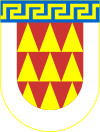
Landmarks Bara Tumba • Bitola Zoo • Heraclea Lyncestis • Ishak Çelebi Mosque • Jeni Mosque • Magnolia Square • Philip II Statue • Širok Sokak • Veluška TumbaSports Education St. Clement of Ohrid University • Music School "Tose Proeski"Events Akto Festival • Si-DoTransportation People Cities and towns in the Republic of Macedonia Berovo · Bitola · Bogdanci · Debar · Delčevo · Demir Hisar · Demir Kapija · Gevgelija · Gostivar · Kavadarci · Kičevo · Kočani · Kratovo · Kriva Palanka · Kruševo · Kumanovo · Makedonska Kamenica · Makedonski Brod · Negotino · Ohrid · Pehčevo · Prilep · Probištip · Radoviš · Resen · Skopje · Struga · Strumica · Sveti Nikole · Štip · Tetovo · Valandovo · Veles · Vinica Categories:
Categories:- Cities in the Republic of Macedonia
- Bitola
Wikimedia Foundation. 2010.

